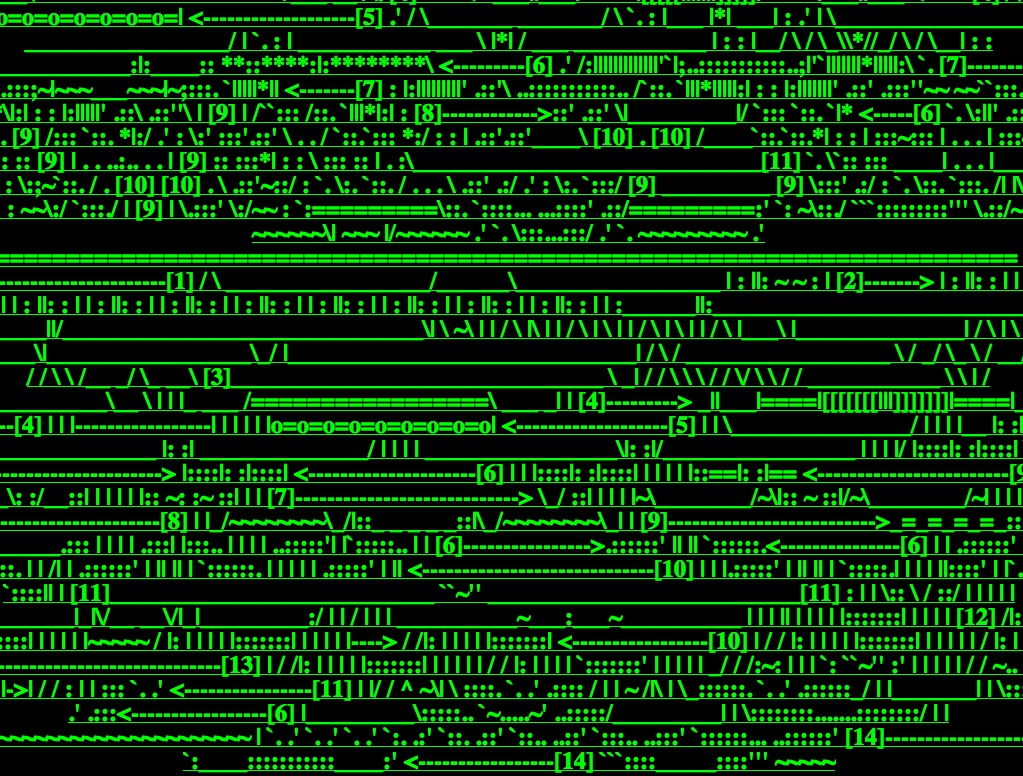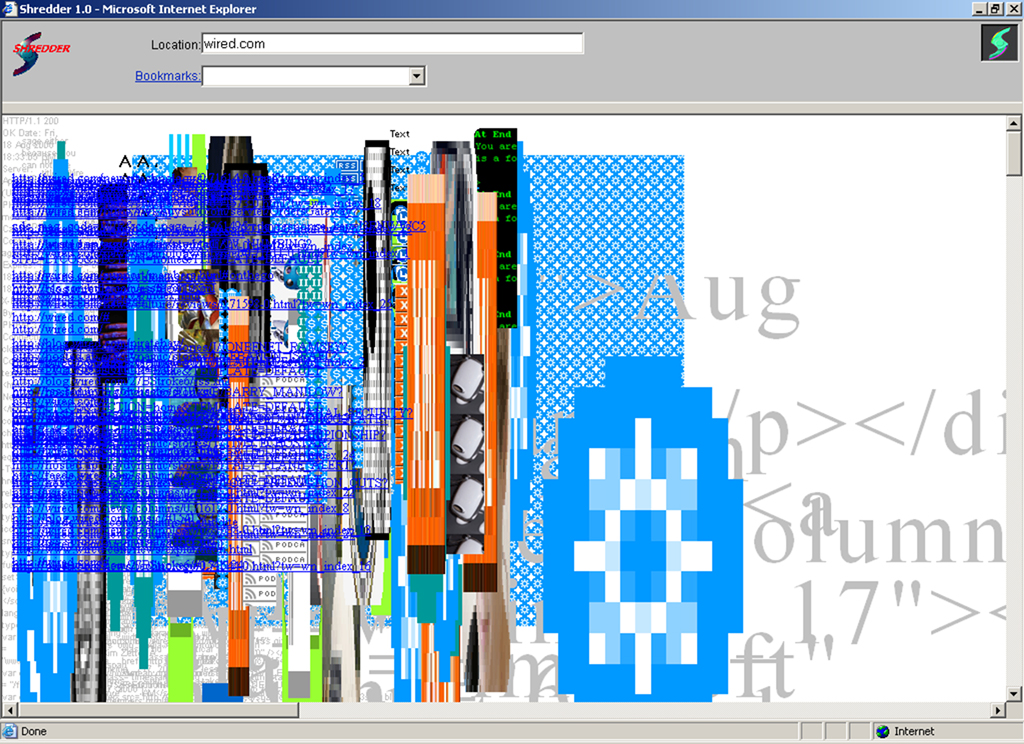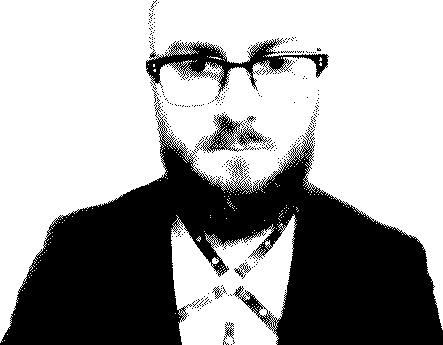Glitch Aesthetics
Description
Week 6: September 17 – 23
The mistakes, errors, artifacts and aberrations of digital processes have in recent years found a central place in contemporary media art, particularly via the Net where emergent low-resolution glitch forms and other so-called “accidents” of artifacts are often native to the medium. We will survey the key artists who have pioneered the art and theory of glitch aesthetics to better understand how this “outlier” form has become an emerging genre. We will also understand the nature of glitch through its history: from early noise musics to collage art and détournement to contemporary methods of resampling and remixing, in which the disruption of the sound or visual is a key component of the expression. Current hactivist and DIY movements and their techniques will be explored to better understand how glitch is a unifying concept that brings together alternative communities of collaborating artists.
Assignments
Due: September 24
Reading:
Niedzviecki, H. (2009) “Peep Diaries: How We’re Learning to Love Watching Ourselves & Our Neighbors” City Light Books
Micro-project VI: Glitched Aberrations
Drawing from the work of Jon Cates and other glitch artists, this project will explore the aberrations, failures, and artifacts that signify this artistic form. See Micro-project VI in Project Assignments for more information.
Research Post V: Private vs Public
You will be assigned an artwork to research for a short written hyperessay about the work, the artist, and how it relates specifically to the topic of next week. Incorporate the reading (see above) for next week into your research, discussing how it relates contextually to the work. Post your hyperessay of approximately 400 words on your blog using relevant hyperlinks, images, video, etc, and remember to add a featured image and to use the “Research” category. You will be expected to share your research post in next week’s class discussion.
- (Diana, Shar) Jennifer Ringley, Jennicam, (1997)
- (Ruzana, Jun) Eva and Franco Mattes, Life Sharing, (2000)
- (MJ, John) Hasan Elahi, Tracking Transience 2.0 (2003)
Outline
Works for study:
Jodi.org, Dirk Paesmans & Joan Heemskerk (1995)

“We are honored to be in somebody’s computer” boast art collective Jodi.org in 1995, who early on in the age of the Web, instantly became the medium’s most celebrated and notorious artists. Their aim was to deconstruct the interface of the Web and reveal the code hidden beneath the surface. Their work essentially functioned as a viral entity that virtually embedded itself into the viewer’s own computer system, as the artists described: “We explore the computer from inside, and mirror this on the net. When a viewer looks at our work, we are inside his computer.’”
- They approach the computer and the creation of their work with a hacker intent: to probe, to disturb, to disrupt.
- The look at the Net as theatrical space, activating the space through coding. Code is for them a vehicle for transformation, for undermining the status quo.
- They were creating glitch art before it was called that. Their intent was to find the accidental disturbances of the machine and its language: to subvert the expectations.
- Ultimately, they have revealed what lies beneath the surface of the “design” of the Web, reversing the role of code as a visual experience, rather than its functional qualities.
Mark Napier, The Shredder (1997)

Mark Napier’s The Shredder from 1997 was designed as a custom browser that enables the viewer to deconstruct or “shred” Websites. This work comes out of a long 20th century practice of appropriation and collage of mass media, with the addition of user interactivity. Napier’s software application gives the viewer the ability to appropriate and generate their own collage work. And like Jodi.org, the work investigates the hidden mechanisms of the Web, revealing the underlying code and its operations.
- Unlike Jodi, Mark Napier brought the viewer into an interactive relationship with subversive, hacker tactics.
- Napier changed the function of the browser into a tool for disruption. One of the first examples of what is now referred to as “software art.”
- In surprising ways, Napier demonstrates a way of viewing the underlying functionality of code as having aesthetic quality.
- This form of collage find its roots in 20th century appropriation of mass media.
Jon Cates, GL1TCH.US, (ongoing)

Describing the world of new media/glitch artist Jon Cates is a labyrinthine task. You might begin with his spontaneous and inventive word-language actions reminiscent of William Burroughs cut-ups; or the hypnotic .gif animations made from seemingly incongruous, discarded fragments of media; or perhaps his “dirty new media” aesthetic that brings to the surface the aberrations and raw imperfections that are typically verboten in “high-end” digital circles.
Jon Cates has ironically and quite cleverly commingled punk and pirate media with thoughtful theoretical discourses. Based in Chicago, he is Chair of Film, Video, New Media and Animation at the School of the Art Institute of Chicago by day, prowling the subculture of the alternative spaces by night. Cates is at the center of a glitch scene in Chicago, now referred to as the “birthplace of dirty new media,” a movement he has in large part catalyzed: spawning the international GLI.TC/H Festivals and other assorted hactivist events and DIY workshops.
In my conversation with Jon Cates we discussed his unique synthesis of language and media, his critique of technology, and how glitch, in all of its multifarious manifestations, has powered his work, functioning as a force for uniting artists, students, and communities in collective activity.
From Glitch Expectations: A Conversation with Jon Cates by Randall Packer
- Jon Cates has constructed his own language, a kind of machine language from the conversion of his writing into typographical alterations.
- He treats the machine system as a landscape for finding the errors, the noise, the artifacts that produce the accidental occurrences of beauty.
- His treatment of artifacts is referred to as “dirty new media,” in direct opposition to the “cleanliness” of media purity found in the high-production values of the technology industry, film industry, in fact any industry!
- His output is prolific, filling feeds of social media, Tumblr, Facebook, Twitter, whatever he can get his hands on: pre-glitch Tumblr feed.
Rosa Menkman, Sunshine in my Throat, (ongoing)

Rosa Menkman, in her inspired treatise on glitch art, The Glitch Moment(um), speaks of the RUPTURE – the departure from conditions of the expected, the normality of the mediated experience – into the BEYOND, where systems fail, aberration prevails, and our preconception of systems and their flow of information is disrupted or even halted. The Ghost in the Machine? A destructive force at work in our digital systems revealed through accidental failures systematic to technology? Or perhaps an intentional act of digital subterfuge: artists searching for new modes of expression through the aesthetic construction of dazzling patterns and the disorientation of pixels.
And yet, Menkman’s critique of the exploding genre of glitch art reveals how little we understand of machines and their potential to fail. It is this lack of understanding that sets the stage for our wonderment of the breakdown, our attraction to the noise, our awe of the strange manifestations that the machine exudes when left to its own devices. Ironically, our design of machines is intended to produce concrete results, functional processes, and predictable behavioral patterns. But the machine is an independent entity in so many ways: it will pull itself back from our feeble attempts of control and wander into otherworldly realms of ephemeral, inexplicable renderings, that even we, the so-called masters of the system, could never imagine. THAT, in essence, is the magic. Like John Cage’s use of chance technique to break from habitual models of creation, the glitch manifested work is often a search for the impossible, in which the machine transcends our finite, human capability to shape reality.
You might call this “computer-assisted composition,” but it is much more than that. The machine is hardly a slave, it is our guide into the other world, a world only IT is native to, an alien world to us made up of blood and flesh. The machine resides in the fantastic world of the electrical and the mechanical, and yes, it can dream impossibly sublime beauty in which we, the artist, become the model posing for its creation.
(From The Ephemerality of the Machine by Randall Packer)
About Xilitla, a video by Rosa Menkman
Glitch studies Manifesto by Rosa Menkman
1. The dominant, continuing search for a noiseless channel has been – and will always be – no more than a regrettable, ill-fated dogma.
Acknowledge that although the constant search for complete transparency brings newer, ‘better’ media, every one of these improved techniques will always possess their own in- herent fingerprints of imperfection.
2. Dispute the operating templates of creative practice. Fight genres, interfaces and expectations!
Refuse to stay locked into one medium or between contradictions like real vs. virtual, ob- solete vs. up-to-date, open vs. proprietary or digital vs. analog. Surf the vortex of technol- ogy, the in-between, the art of artifacts!
3. Get away from the established action scripts and join the avant-garde of the unknown. Become a nomad of noise artifacts!
The static, linear notion of information-transmission can be interrupted on three oc- casions: during encoding-decoding (compression), feedback or when a glitch (an unex- pected break within the flow of technology) occurs. Noise artists must exploit these noise artifacts and explore the new opportunities they provide.
4. Employ bends and breaks as metaphors for différance. Use the glitch as an exoskel- eton for progress.
Find catharsis in disintegration, ruptures and cracks; manipulate, bend and break any medium towards the point where it becomes something new; create glitch art.
5. Realize that the gospel of glitch art also tells about new standards implemented by corruption.
Not all glitch art is progressive or something new. The popularization and cultivation of the avant-garde of mishaps has become predestined and unavoidable. Be aware of easily reproducible glitch effects automated by softwares and plug-ins. What is now a glitch will become a fashion.
6. Force the audience to voyage through the acousmatic videoscape.
Create conceptually synaesthetic artworks that exploit both visual and aural glitch (or other noise) artifacts at the same time. Employ these noise artifacts as a nebula to shroud the technology and its inner workings and to compel an audience to listen and watch more exhaustively.
7. Rejoice in the critical trans-media aesthetics of glitch artifacts.
Utilize glitches to bring any medium into a critical state of hypertrophy, to (subsequently) criticize its inherent politics.
8. Employ Glitchspeak (as opposed to Newspeak) and study what is outside of knowl- edge. Glitch theory is what you can just get away with!
Flow cannot be understood without interruption, nor function without glitching. This is why glitch studies is necessary.
- Rosa Menkman has incorporated into her work a scientific approach to noise and glitch art, research the origins of communications theory through the writings of Claude Shannon, in order to understand how messages are composed, transmitted and received, and how noise inherently enters into these transmissions.
- She has taken this approach to the systematic hacking of various codecs, image formats, compression artifacts, downsampling, to better understand how they might be artistically broken down, databent, deconstructed, hacked.
- She has helped unlock the door for artists to expand on their own hacking processes through her theoretical and historical approach to glitch.
Guides to Hacking and Glitching
We will have an in class project and take home, found in:
Micro-project VI: Glitched Aberations
The following are tutorials to guide you in your glitch studies:
A Vernacular of File Formats by Rosa Menkman
To Hold a Future so Close to One’s Own by Evan Meaney
Data Bending and Glitch Art Primer by Stalio’s Way
For those ambitious souls who would like to learn how to create open source codecs for purposes of hacking, here is Nick Briz’ excellent tutorial. Not for the feint of heart! And the link to his Website.
Here is Nick’s FAQ Video if you need more help:
To consider for our final project:
Glitch art demonstrates how artists work together to produce their own DIY culture, in which art functions as a social organism for collaboration and collective work. The show currently running in Chicago is an example of this: their Facebook group, glitChicao is a dynamic exchange of glitch work, ideas, processes, and various manifestoes.
We have discussed the idea of a data visualization project. How could we expand on this idea to create a more social experience, not just presenting work, but presenting tools and processes for others to contribute. Think about this as we move closer to the realization of our final project.